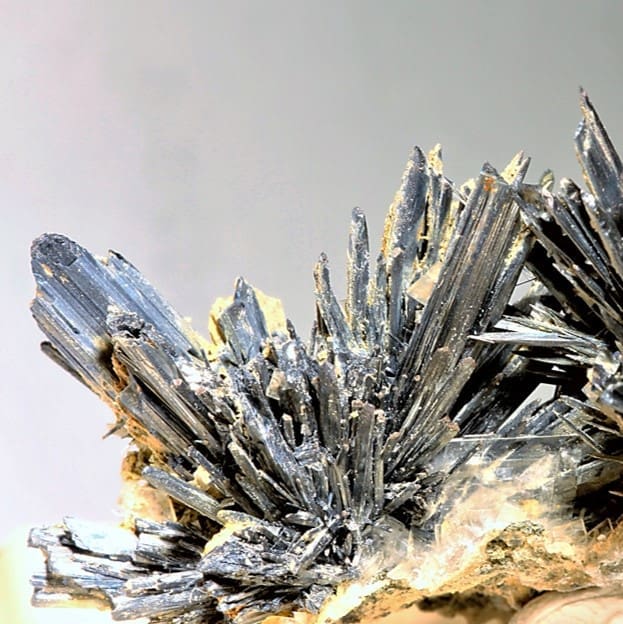
Antimonium crudum
Latin name: Antimonium crudum
Short name: Ant-c
Common name: Black Sulphide of Antimony | Crude Antimony | Stibnite
Primary miasm: Psoric Secondary miasm(s): Sycotic
Kingdom: Minerals
Family: Metalloid compound (Antimony and Sulphur)
- Symptomatology
- Remedy Information
- Differentiation & Application
Derived from the natural mineral Stibnite, a black, crystalline sulphide of antimony (Sb₂S₃). Used historically in cosmetics (kohl), medicine, and alchemical processes. In its crude form, it is toxic, causing gastrointestinal irritation and systemic weakness. It is prepared homeopathically via trituration and potentisation.
Traditionally used as a purgative and emetic in ancient and medieval medicine; also used in cosmetics and metallurgy. Crude antimony is toxic and no longer used in orthodox medicine.
Proved by Samuel Hahnemann and included in his Materia Medica Pura. Later expanded by Hering, Allen, Clarke, and others.
- Gastrointestinal tract – stomach, intestines, tongue
- Skin and mucous membranes – pustules, crusts, callosities
- Mind and mood – irritability, sentimentality, oversensitivity
- Limbs and joints – painful, stiff joints with aggravation from heat and touch
- Nails and extremities – thickened nails, corns, calluses
- Respiratory mucosa – chronic catarrhal states
- Children – especially for gastric and behavioural complaints
- Elderly – for weakness, indigestion, and skin issues
- Gastrointestinal tract – stomach, intestines, tongue
- Skin and mucous membranes – pustules, crusts, callosities
- Mind and mood – irritability, sentimentality, oversensitivity
- Limbs and joints – painful, stiff joints with aggravation from heat and touch
- Nails and extremities – thickened nails, corns, calluses
- Respiratory mucosa – chronic catarrhal states
- Children – especially for gastric and behavioural complaints
- Elderly – for weakness, indigestion, and skin issues
- Heat in any form – sun, heated room, warm bathing (especially skin symptoms)
- Cold bathing (some exceptions)
- After overeating or indulgence
- Fatty, sour, or acidic foods
- Wine, vinegar, acidic fruits
- Emotional rejection or criticism
- Night (especially skin and cough symptoms)
- Touch (especially of painful areas)
- Sulphur – Also has skin and gastric symptoms, but more burning and intellectual restlessness
- Calcarea carbonica – Also sensitive children with scalp eruptions, but more sweat and constitutional weakness
- Pulsatilla – Similar indigestion, but more emotional softness and weepiness
- Hepar sulphuris – Skin eruptions with hypersensitivity and suppuration, but more intense irritability
- Lycopodium – Digestive issues with flatulence and fear of public failure
- Complementary: Sulphur, Pulsatilla
- Antidotes: Hepar sulph., Chamomilla
- Follows well: Nux vomica, after overindulgence
- Inimical: Vinegar, wine (incompatible substances aggravate all states)
At its core, Antimonium crudum is the remedy of excess and hypersensitivity. It speaks to those who are irritable, overindulgent, and physically intolerant of touch, heat, or contradiction. Whether it is a child who cannot bear affection, or an adult with indigestion from rich food, or an elder with calloused skin and stiff joints, Antimonium crudum provides relief when internal congestion manifests externally—as pustules, moodiness, or gastric burden. It suits individuals who retreat into irritability and self-protection, often mirroring the thick crusts and calluses that define its skin and soul.
- Excellent for gastric affections from overeating
- A top remedy for cradle cap, acne, and thick skin eruptions
- Helpful in children who are irritable, chunky, and resist affection
- Useful in gout and joint pain < heat
- Consider in elderly with indigestion and skin disorders
- White-coated tongue is a leading keynote in gastric cases
Mind
- Morose, sulky
- Irritable from contradiction
- Aversion to being touched
- Sentimental, weeps from music
Stomach
- Nausea with white-coated tongue
- Indigestion from overeating
- Eructations tasting of food
Skin
- Eruptions crusty, pustular
- Warts, thick skin
- Itching < heat, < bathing
Extremities
- Corns and callosities
- Pain < heat and touch
- Nails thick and brittle
Generalities
- Worse heat, bathing, touch
- Better open air
- Better rest and solitude
- Samuel Hahnemann – Materia Medica Pura: Core proving symptoms including white-coated tongue, irritability, and gastric aggravations
- C. Hering – Guiding Symptoms: Noted skin, gastric, and mental features; therapeutic applications in children
- James Kent – Lectures on Homoeopathic Materia Medica: Emphasised mental sensitivity, skin callosities, and heat intolerance
- William Boericke – Pocket Manual: Practical insights on gastric and skin applications
- John Henry Clarke – Dictionary of Practical Materia Medica: Full picture of skin, mind, and stomach, with therapeutic guidance
